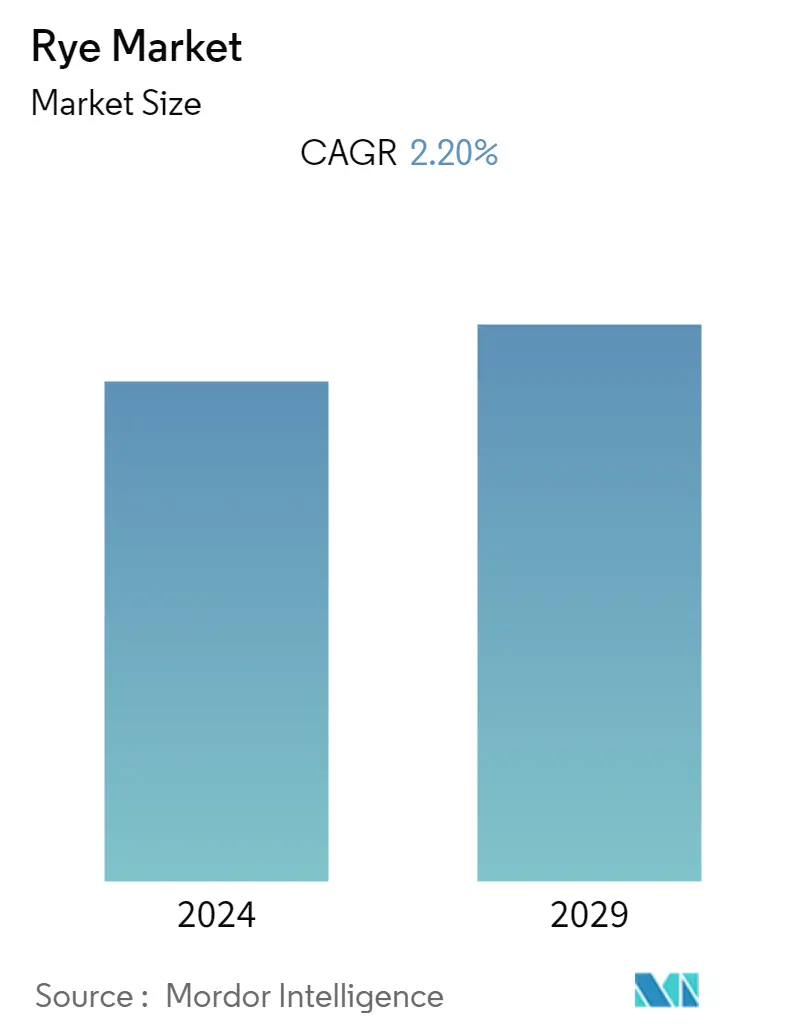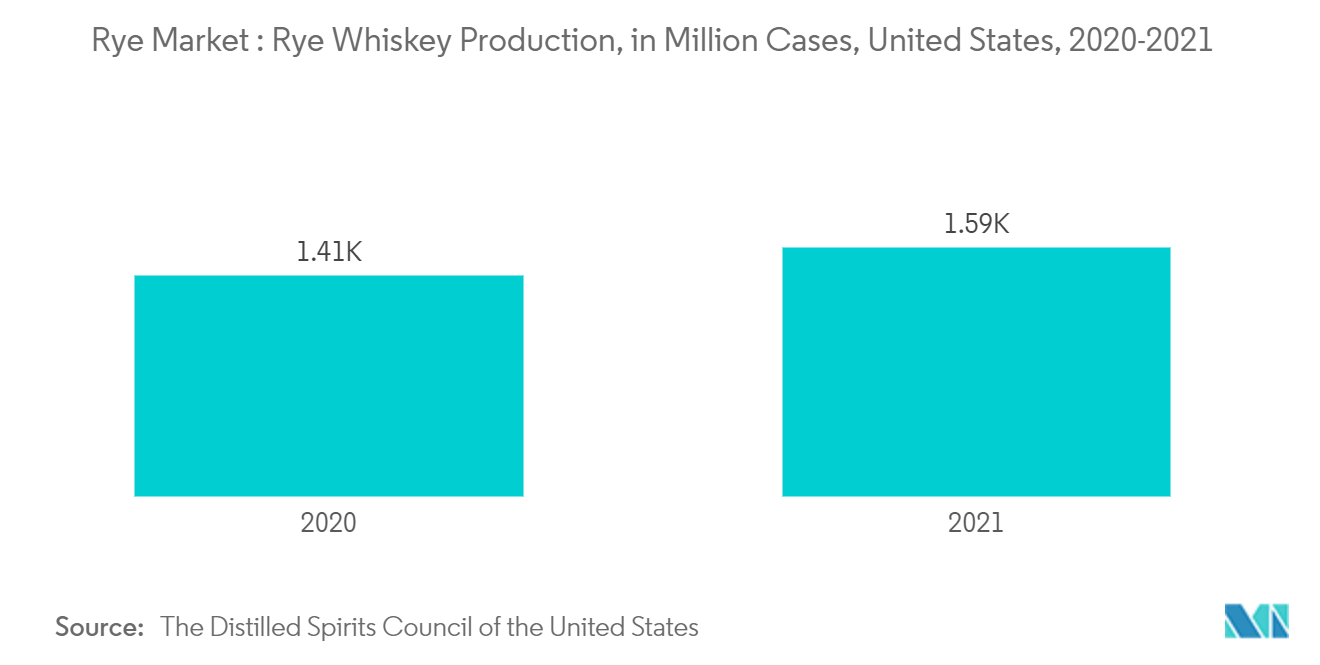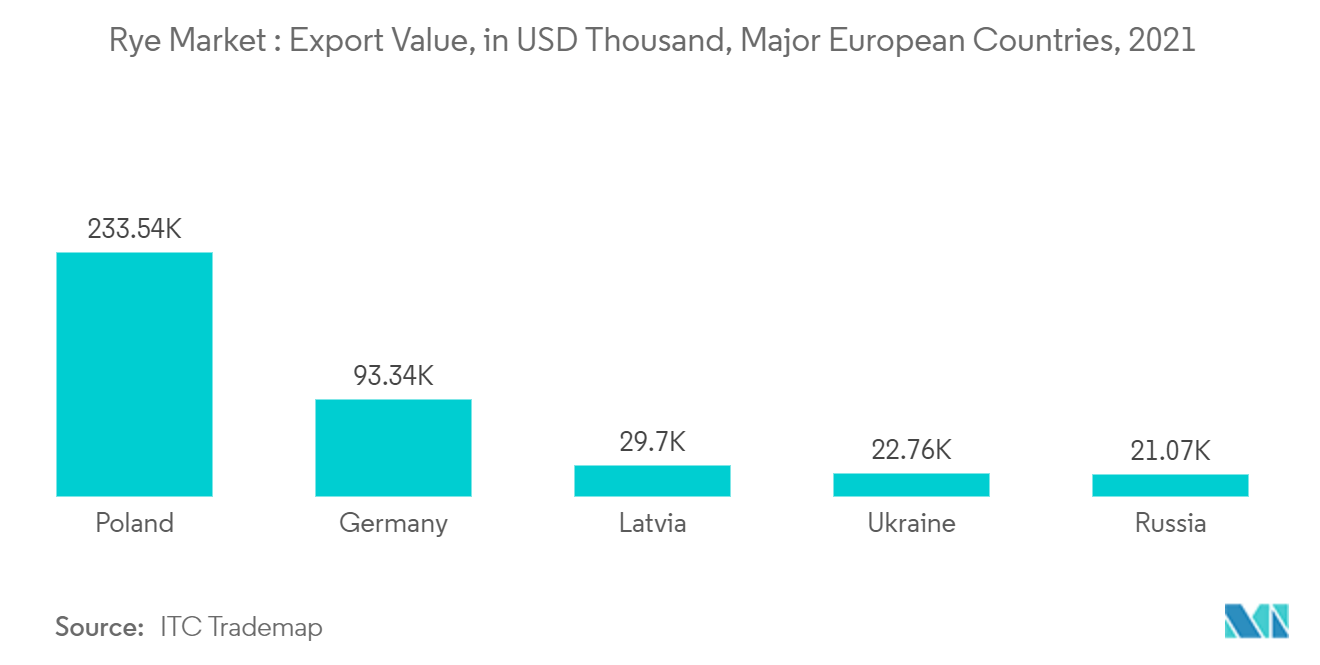Rye Market Size

| Study Period | 2019 - 2029 |
| Base Year For Estimation | 2023 |
| Forecast Data Period | 2024 - 2029 |
| CAGR | 2.20 % |
| Fastest Growing Market | North America |
| Largest Market | Europe |
Major Players*Disclaimer: Major Players sorted in no particular order |
Rye Market Analysis
The rye market is projected to register a CAGR of 2.2% over the forecast period.
- Rye is a good source of vitamin B6, thiamine, niacin, iron, folate, fiber, and riboflavin. Rye also contains small amounts of zinc, pantothenic acid, phosphorus, magnesium, calcium, and other micronutrients. Rye can improve heart health, aid blood sugar control, assist digestive health, reduce inflammations, and reduce the risk of several cancers.
- According to the Food and Agriculture Organization (FAO), Germany, Poland, Russia, Belarus, Denmark, Ukraine, and China are the major producer of rye across the globe contributing 3,325.6 thousand metric tons, followed by 2,472.8 thousand metric tons, 1,721.9 thousand metric tons, 845 thousand metric tons, 672.4 thousand metric tons, 593.1 thousand metric tons, and 512.2 thousand metric tons during the year 2021.
- Rye is the most important crop in most European countries. Rye is a comparatively modern crop with production majorly in Northern Europe. Rye plays a very important role in countries with poor-quality soil and can also handle colder temperatures compared to other grains. The increase in demand in the food and beverage processing industry is driving its market growth during the forecast period.
- Rye whiskey derives its unique spicy and flavorful characteristics from the complexity of the grain. Some newer hybrids, like Abruzzese Rye, Danko Rye, and Brasetto Rye used by distillers, brewers, and bakers, are being tested especially for climate and soil conditions by Universities in the region like Penn State. These varieties are also commonly used as cover crops.
Rye Market Trends
This section covers the major market trends shaping the Rye Market according to our research experts:
Rise in Demand from the Food and Beverage Processing Industry
- Rye is commonly consumed in northern and eastern Europe as its energy, and micronutrient content is similar to other cereals. However, it is consumed mostly as whole-grain bread as it has considerable dietary fiber. Rye products play a central role in the Finnish diet. Rye grain is used for flour, bread, beer, crispbread, whiskeys, vodkas, and animal fodder. It can also be eaten whole, as boiled rye berries, or rolled, similar to rolled oats.
- In Russia, the consumption of rye is popularly found in a traditional fermented drink known as Kvass, which is made by brewing rye bread and sugar. It is mostly consumed in the summertime and has very low alcohol content. The increase in demand from the food and beverage processing industry is driving the market growth for rye during the forecast period.
- Rye is popular in Eastern Europe, with most of the world's crops grown in Russia, Poland, and Germany. Many common food and beverages contain rye, including bread, crackers, beer, and whiskey. Rye berries can also be eaten whole, rolled into flakes, and eaten as cereal. Rye bread can be made with light or dark rye flour. Light rye flour has a tan or taupe color, and light flavor, containing only a small amount of the rye berry's outer bran shell. In the United States, rye whiskey refers to whiskey that has been distilled using at least 51 percent rye (the remainder of which comprises corn and barley).

Europe Dominates the Market
- Rye is grown primarily in Eastern, Central, and Northern Europe. The main rye belt stretches from northern Germany through Poland, Ukraine, Belarus, Lithuania, and Latvia into central and northern Russia. Germany and Poland are the main producing and consuming countries for rye in Europe.
- Around half of the produced rye is used in animal feeds. The increased demand for rye in alcohol production has further stimulated its consumption demand within the region during the forecast period.
- This crop's yield remained high, allowing EU countries to trade rye with other countries. According to Euro statistics, domestic prices in the EU have become lower so that this crop can be exported. Domestic prices for rye in the EU are highly dependent on the cost of corn. The main suppliers of this crop are Latvia, Estonia, and Poland.
- However, high rye yields are traditionally observed in Germany (up to 3500 thousand tons in 2020) and Denmark (up to 725 thousand tons in 2020). As per the Food and Agriculture Organization (FAO), the total area harvested in Russia accounted for 998.8 thousand hectares, followed by Poland with 761.6 thousand hectares, and Germany with 631.0 thousand hectares, which will further propel market growth in coming years.

Rye Market News
- January 2023: Powers Irish Whiskey launched the world's first 100% Irish rye whiskey bottled at 43.2% ABV. Powers Irish Rye is released in the United States, Ireland, Northern Ireland, Dublin Airport, and online platforms.
- August 2021: In the United States, northeastern Iowa farmers used hybrid rye to help reduce ragweeds without using herbicides on the row crops such as corn and soy.
Rye Market Report - Table of Contents
1. INTRODUCTION
- 1.1 Study Assumptions & Market Definition
- 1.2 Scope of the Study
2. RESEARCH METHODOLOGY
3. EXECUTIVE SUMMARY
4. MARKET DYNAMICS
- 4.1 Market Overview
- 4.2 Market Drivers
- 4.3 Market Restraints
- 4.4 Value Chain Analysis
5. MARKET SEGMENTATION
-
5.1 Geography
- 5.1.1 North America
- 5.1.1.1 United States
- 5.1.1.1.1 Production Analysis
- 5.1.1.1.2 Consumption Analysis and Market Value
- 5.1.1.1.3 Import Market Analysis (Volume & Value)
- 5.1.1.1.4 Export Market Analysis (Volume & Value)
- 5.1.1.1.5 Price Trends Analysis
- 5.1.1.2 Canada
- 5.1.1.2.1 Production Analysis
- 5.1.1.2.2 Consumption Analysis and Market Value
- 5.1.1.2.3 Import Market Analysis (Volume & Value)
- 5.1.1.2.4 Export Market Analysis (Volume & Value)
- 5.1.1.2.5 Price Trends Analysis
- 5.1.2 Europe
- 5.1.2.1 Germany
- 5.1.2.1.1 Production Analysis
- 5.1.2.1.2 Consumption Analysis and Market Value
- 5.1.2.1.3 Import Market Analysis (Volume & Value)
- 5.1.2.1.4 Export Market Analysis (Volume & Value)
- 5.1.2.1.5 Price Trends Analysis
- 5.1.2.2 Ukraine
- 5.1.2.2.1 Production Analysis
- 5.1.2.2.2 Consumption Analysis and Market Value
- 5.1.2.2.3 Import Market Analysis (Volume & Value)
- 5.1.2.2.4 Export Market Analysis (Volume & Value)
- 5.1.2.2.5 Price Trends Analysis
- 5.1.2.3 Russia
- 5.1.2.3.1 Production Analysis
- 5.1.2.3.2 Consumption Analysis and Market Value
- 5.1.2.3.3 Import Market Analysis (Volume & Value)
- 5.1.2.3.4 Export Market Analysis (Volume & Value)
- 5.1.2.3.5 Price Trends Analysis
- 5.1.2.4 Poland
- 5.1.2.4.1 Production Analysis
- 5.1.2.4.2 Consumption Analysis and Market Value
- 5.1.2.4.3 Import Market Analysis (Volume & Value)
- 5.1.2.4.4 Export Market Analysis (Volume & Value)
- 5.1.2.4.5 Price Trends Analysis
- 5.1.3 Asia-Pacific
- 5.1.3.1 China
- 5.1.3.1.1 Production Analysis
- 5.1.3.1.2 Consumption Analysis and Market Value
- 5.1.3.1.3 Import Market Analysis (Volume & Value)
- 5.1.3.1.4 Export Market Analysis (Volume & Value)
- 5.1.3.1.5 Price Trends Analysis
- 5.1.3.2 Australia
- 5.1.3.2.1 Production Analysis
- 5.1.3.2.2 Consumption Analysis and Market Value
- 5.1.3.2.3 Import Market Analysis (Volume & Value)
- 5.1.3.2.4 Export Market Analysis (Volume & Value)
- 5.1.3.2.5 Price Trends Analysis
- 5.1.4 South America
- 5.1.4.1 Brazil
- 5.1.4.1.1 Production Analysis
- 5.1.4.1.2 Consumption Analysis and Market Value
- 5.1.4.1.3 Import Market Analysis (Volume & Value)
- 5.1.4.1.4 Export Market Analysis (Volume & Value)
- 5.1.4.1.5 Price Trends Analysis
- 5.1.4.2 Argentina
- 5.1.4.2.1 Production Analysis
- 5.1.4.2.2 Consumption Analysis and Market Value
- 5.1.4.2.3 Import Market Analysis (Volume & Value)
- 5.1.4.2.4 Export Market Analysis (Volume & Value)
- 5.1.4.2.5 Price Trends Analysis
- 5.1.5 Middle East
- 5.1.5.1 Turkey
- 5.1.5.1.1 Production Analysis
- 5.1.5.1.2 Consumption Analysis and Market Value
- 5.1.5.1.3 Import Market Analysis (Volume & Value)
- 5.1.5.1.4 Export Market Analysis (Volume & Value)
- 5.1.5.1.5 Price Trends Analysis
- 5.1.5.2 Israel
- 5.1.5.2.1 Production Analysis
- 5.1.5.2.2 Consumption Analysis and Market Value
- 5.1.5.2.3 Import Market Analysis (Volume & Value)
- 5.1.5.2.4 Export Market Analysis (Volume & Value)
- 5.1.5.2.5 Price Trends Analysis
6. MARKET OPPORTUNITIES & FUTURE TRENDS
** Subject To AvailablityRye Industry Segmentation
Rye is one of the important field crops grown for food and forage use. The crop belongs to the triticale family. The grain is extensively used as an ingredient in bakery products, alcoholic beverages, and animal feed.
The rye market is segmented by geography into North America, Europe, Asia-Pacific, South America, and the Middle East. The report offers an analysis of production (volume), consumption (value and volume), import (value and volume), export (value and volume), and price trend analysis.
The report offers market size and forecasts in terms of value (USD thousand) and volume (metric ton) for all the above segments.
| Geography | North America | United States | Production Analysis |
| Consumption Analysis and Market Value | |||
| Import Market Analysis (Volume & Value) | |||
| Export Market Analysis (Volume & Value) | |||
| Price Trends Analysis | |||
| Geography | North America | Canada | Production Analysis |
| Consumption Analysis and Market Value | |||
| Import Market Analysis (Volume & Value) | |||
| Export Market Analysis (Volume & Value) | |||
| Price Trends Analysis | |||
| Geography | Europe | Germany | Production Analysis |
| Consumption Analysis and Market Value | |||
| Import Market Analysis (Volume & Value) | |||
| Export Market Analysis (Volume & Value) | |||
| Price Trends Analysis | |||
| Geography | Europe | Ukraine | Production Analysis |
| Consumption Analysis and Market Value | |||
| Import Market Analysis (Volume & Value) | |||
| Export Market Analysis (Volume & Value) | |||
| Price Trends Analysis | |||
| Geography | Europe | Russia | Production Analysis |
| Consumption Analysis and Market Value | |||
| Import Market Analysis (Volume & Value) | |||
| Export Market Analysis (Volume & Value) | |||
| Price Trends Analysis | |||
| Geography | Europe | Poland | Production Analysis |
| Consumption Analysis and Market Value | |||
| Import Market Analysis (Volume & Value) | |||
| Export Market Analysis (Volume & Value) | |||
| Price Trends Analysis | |||
| Geography | Asia-Pacific | China | Production Analysis |
| Consumption Analysis and Market Value | |||
| Import Market Analysis (Volume & Value) | |||
| Export Market Analysis (Volume & Value) | |||
| Price Trends Analysis | |||
| Geography | Asia-Pacific | Australia | Production Analysis |
| Consumption Analysis and Market Value | |||
| Import Market Analysis (Volume & Value) | |||
| Export Market Analysis (Volume & Value) | |||
| Price Trends Analysis | |||
| Geography | South America | Brazil | Production Analysis |
| Consumption Analysis and Market Value | |||
| Import Market Analysis (Volume & Value) | |||
| Export Market Analysis (Volume & Value) | |||
| Price Trends Analysis | |||
| Geography | South America | Argentina | Production Analysis |
| Consumption Analysis and Market Value | |||
| Import Market Analysis (Volume & Value) | |||
| Export Market Analysis (Volume & Value) | |||
| Price Trends Analysis | |||
| Geography | Middle East | Turkey | Production Analysis |
| Consumption Analysis and Market Value | |||
| Import Market Analysis (Volume & Value) | |||
| Export Market Analysis (Volume & Value) | |||
| Price Trends Analysis | |||
| Geography | Middle East | Israel | Production Analysis |
| Consumption Analysis and Market Value | |||
| Import Market Analysis (Volume & Value) | |||
| Export Market Analysis (Volume & Value) | |||
| Price Trends Analysis |
Rye Market Research FAQs
What is the current Rye Market size?
The Rye Market is projected to register a CAGR of 2.20% during the forecast period (2024-2029)
Which is the fastest growing region in Rye Market?
North America is estimated to grow at the highest CAGR over the forecast period (2024-2029).
Which region has the biggest share in Rye Market?
In 2024, the Europe accounts for the largest market share in Rye Market.
What years does this Rye Market cover?
The report covers the Rye Market historical market size for years: 2019, 2020, 2021, 2022 and 2023. The report also forecasts the Rye Market size for years: 2024, 2025, 2026, 2027, 2028 and 2029.
Rye Industry Report
Statistics for the 2024 Rye market share, size and revenue growth rate, created by Mordor Intelligence™ Industry Reports. Rye analysis includes a market forecast outlook 2029 and historical overview. Get a sample of this industry analysis as a free report PDF download.



